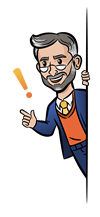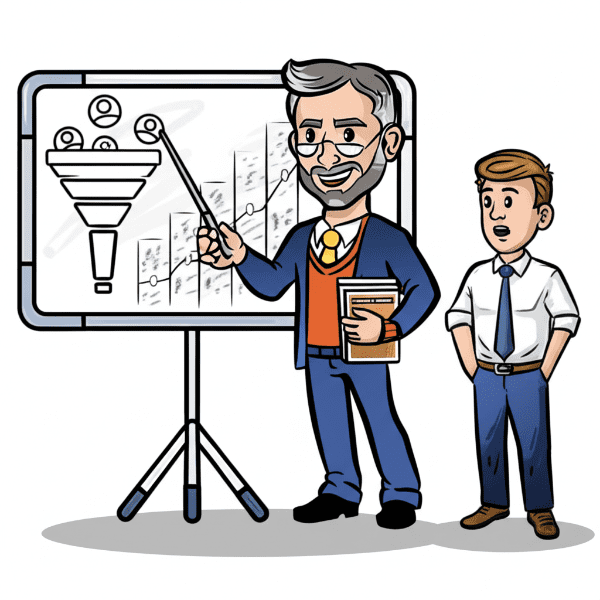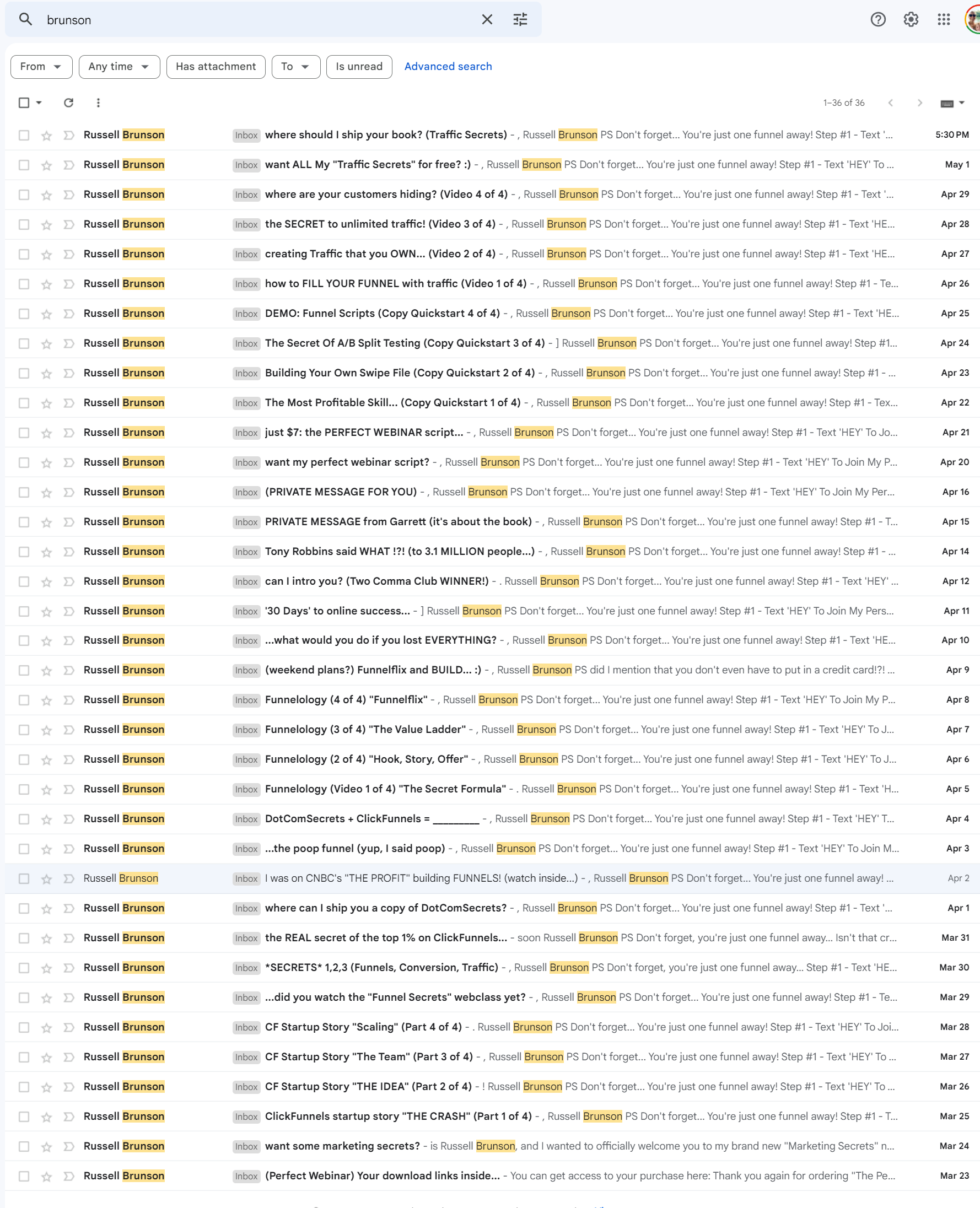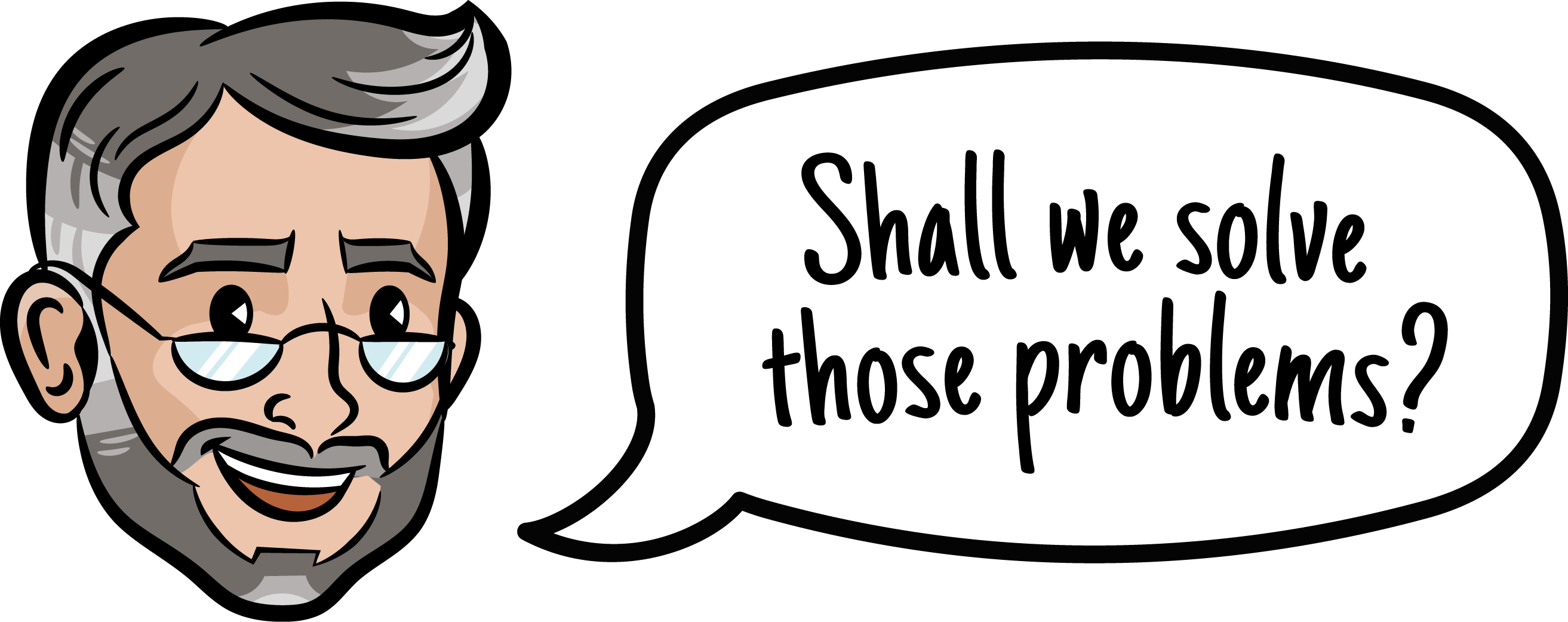In this article, we’ll explore the meaning of one and done, the most common beginner error for both sales folks and marketers, why it’s so common, and what to do about it.
For CEO’s and other decision-makers trying to get a new product or service launched or even a whole new business going, a one and done error can be fatal.
In a more mature approach, everything sales and marketing is evaluated with an eye towards statistical relevance and actual human buying behavior.
Read on to better understand one and done’s meaning and whether or not you or your organization might be guilty of throwing up the white flag on perfectly viable sales funnels way too soon. If you need help explaining sales funnels to your staff or students try our free sales funnel illustrations.

Professor’s Note:
One and done definition: a single-touch approach to sales or marketing, where no further effort is made after a first touch.
On top of rarely generating any revenue, inaccurate conclusions are often drawn.
Table of Contents
What’s a Touch in Sales & Marketing?
Our one and done meaning defined it as a “single-touch approach,” but what does that mean?
Touches are discrete times where your brand and/or offering are put in front of your target buyer, whether or not they even realize it. If you need a refresher, we have compiled a growing list of sales jargon.
Marketers create touches with various types of asynchronous communications such as advertisements including:
- Billboards
- Newsletters
- TV Ads
Driving by a billboard would count as a single touch.
Sales people such as SDRs create touches by interacting with people. Examples include:
- Cold calls
- Directed Emails
- Tradeshow Greetings
Each discrete call, email, etc. is a single touch.
Savvy sales and marketing professionals track each touch as closely as they can and use them to map a user or buyer journey.
So here at SFP, when we do Sales Funnel Audits, we’re documenting all those touches and making recommendations to make them work better individually so that less overall touches are needed and the sales cycle shortens.
That type of work, especially when applied to a digital funnel using a website, is often referred to as conversion rate optimization and the people who provide that service are sometimes called “CRO experts.”
What Does One and Done Mean in Marketing?
So, what does one and one mean in marketing?
Two very common “one and done” events occur in beginner marketing:
The Newsletter Failure
What’s the scenario? Someone comes up with the bright idea of sending an email newsletter, goes to a ton of effort to make it beautiful stylistically, writes way too much, ropes in lots of team members to talk about it, and sends it.
What are the results? Somewhere between 8 and 30% of the recipients open it. Somewhere between 0% and .5% click something. Sometimes a warning comes from Mailchimp or HubSpot to stop buying lists because over 5% of the emails bounce. No sales happen.
What happens next? Someone in finance looks at all the team’s effort to come up with the email, declares the ROI as zero, and tells them to try something else.
The Digital Ad Failure
What’s the scenario? Someone has the bright idea of using search ads (PPC as top of funnel) or social media ads, spends a ton of effort on graphic design and headline analysis, uses too many dollars and not enough targeting analysis, and sets it to run for a week.
What are the results? Virtually no impressions or clicks happen the first few days. Then a few start to trickle in on day 3, all of them bounce on the landing page, and the ads engine suggests 20 ways to further optimize. No sales happen.
What happens next? Someone in finance looks at all the team’s effort to come up with the designs and copy, sums up the cost of labor with the ad spend, and declares defeat, and tells the team to go back to the drawing board.
Notice that someone in finance is the enemy? There’s this common misconception that sales and marketing spend pays immediate dividends and that all investment in it should have a return immediately.
The reality is that sales and marketing results shouldn’t generally be tabulated until at least the second month, and the more complex the sale, the longer the sales cycle will be.

Professor’s Note:
Sales and marketing campaigns are a lot more like Maglites than juke boxes. If you put a coin in a juke box, you get a song. Immediate return on spend.
If you put one battery in a Maglite, nothing happens. If you put two batteries in a Maglite, nothing happens. If you put six batteries in a Maglite, the light comes on (and you’ve got a formidable weapon).
There are plenty of other one and done approaches to marketing campaigns, but they all share one common thread. Each potential buyer is a stranger who is touched at most once and “terminated” before subsequent touches occur.
More seasoned marketers design a series of touches into every campaign and often those touches are coming from different places (known as Omni-channel Marketing).
In a one-and-done scenario, defeat may be declared without the prospect even being aware they were made an offer.
What Does One and Done Mean in Sales?
We talked about one and done marketing scenarios above. One and one in sales is similar but instead of a hands-off touch, it’s a salesperson actively attempting to start a conversation with potential buyer.
1st sales touches are often digital these days:
- An email
- A social media mention
- A request to connect on social media
And then there’s a good old-fashioned cold call.
Before a call happens, there’s the acquisition of a contact. It could be scanning LinkedIn. It could be a list provided by a tradeshow your firm attended.
Whatever it is, there’s typically a core “pitch” that will be attempted within that touch. Here’s a real example (with the company name omitted:
Hi Eddie,
I hope you are doing great!
Greetings from [company X].
We are a professional software development agency. I can help you with Redesigning/developing the website & SEO Services. We have skilled Programmers in e-Commerce, PHP, JAVA, .Net, Delphi, IOS, Android, and Testing QA analysts & Blockchain Development
Please let us know if there are any projects where we can collaborate?
Regards
Chris
At SFP, we’ve worked in software for many years, so we get a variation of this pitch almost every day. I chose this one out of my LinkedIn inbox because it was sent 14 business days ago with no follow-up on LinkedIn and no cross-channel communication (cold call or direct email).
Since I didn’t respond, Chris or his boss might surmise that his pitch was no good or even worse, that their outsourced software development model is a failure.
Did they? It’s hard to say because it appears to be a one and done and prospects rarely respond to a touch outside of the first 48 hours after receipt.
What’s worse? Chris appeared to be a junior salesperson. How did he take it if he sent that LinkedIn message 400 times in a week and no one responded? Hopefully, someone who knows how sales funnels work is around to talk him off the ledge.
What Is a “Close It or Kill It” Approach?
When we look at touches on a prospect’s contact record in a HubSpot audit, we want to see whether or not a “close-it-or-kill-it” approach was run.
Using the touch-1 outreach from Chris above, we would have recommended sharing a link to the website where something of value is living. If I had visited their website, Chris’s company could have cookied me and started serving me ads on other sites to get subsequent touches on me in an automated way.
For Chris’s team, we would have hoped to see good CRM hygiene showing his LinkedIn outreach as touch-1, and then perhaps 3-4 emails and a cold call over the next 2 weeks.
In “close-it-or-kill-it,” touches continue until the prospect either becomes a customer or definitively answers that they will not be purchasing. With either outcome, it’s 100% clear that the prospect knows what the offering is because a salesperson has made contact and received return correspondence either by phone or email.
What Does a Sales Funnel Do?
As opposed to the one and done marketing and sales approaches discussed above, an optimized sales funnel assumes that many prospects will need a number of touches to move through at least 3 distinct stages: top, middle and bottom.
In reality, we use more funnel stages when we do HubSpot configurations (or the CRM of your choice), but a 3-stage sales funnel is easier to understand.
At the top of the funnel, it’s about getting someone’s attention and then quickly giving them a reason to care enough to mentally engage.
Great marketers and sales people know this takes lots of touches.
Why? Oh, the reasons are so many…
- Even the most interesting products are not really that interesting when compared to fun, friends, family, food, alcohol, sex, etc.
- Other decisions have been prioritized higher.
- Your prospect is so busy they can’t even think about you pitched.
- Your prospect never saw your email.
- Your prospect uses Google to screen all incoming calls.
…And the lists goes on.

Your pitch may have been spot on. Your product may be amazing. You may have put that touch on the perfect person. And then nothing happened.
Great sales funnels take it for granted that people are busy, 1st touches often amount to nothing, and many subsequent touches may not even register. They then categorize a particular person as being in a particular part of the funnel based on the degree to which they are engaging.
How Can a Great Marketing & Sales Stack Make One and Done Avoidable?
So let’s take two things for granted:
- Your product is awesome, but no prospect thinks it’s as awesome as you do or anywhere close to their highest priority.
- No human likes repeating themselves (unless you’re a politician).
Enter a great sales and marketing stack.
There are standalone “Marketing Automation” and “Sales Automation” tools that are perfectly happy to repeat themselves and can get those touches out there automatically, and even make it look like a human cared enough to write 20 emails, if that’s what you’re looking for.
What Does Marketing Automation Do?
A common use of marketing automation is to offer something of value such as a white paper for free if the client will share an email address in exchange.
Click Funnels has become known for helping junior/ and non-marketers get their message across by sending tons of correspondence thereafter.
You can trigger email automation in HubSpot or other modern CRMs without downgrading to a more basic platform, however.
With a series of emails, you assume not everyone will get read, and good systems will actually tell you which of all your emails were read.
What Does Sales Automation Do?
Whereas emails that follow a download by a stranger are considered “marketing emails,” you can also find the email of the person you want to reach through many methods including lead generation services such as Seamless.ai.
So that person hasn’t interacted with you at all? Not a problem. Put them in a standalone sales automation tool or a CRM with sales automation built-in and you can have a series of emails go out to them every 3rd business day until they either respond positively or tell you to “FO.”
These outbound, one-off tools generally refer to that feature as either “sequences” or “cadences.”
How Does the Hierarchy of Effects Model Apply?
Whereas a sales funnel often generalizes the present stage of a particular buyer on their journey as being at one of three spots in the funnel, a psychology-based approach uses more stages.
One of the better ones is called the Hierarchy of Effects model.
Buyers start their journey with thinking. Then they develop feelings. And last, they make a decision to act and then follow-through.
Using the “Awareness” stage as an example, lots of touches are required. With how inundated with offers we are at all times, we have to see a brand many times before we even recognize that we have seen its logo before.
Awareness (Cognitive)
Knowledge (Cognitive)
Liking (Affective)
Preference (Affective)
Conviction (Conative)
Purchase (Conative) -> $$$

Professor’s Note:
The purpose of what we call “full” sales funnel audits is to map and analyze the entire Hierarchy of Effects model for a single audience<>value proposition pair.
If you have multiple audiences and/or multiple value propositions, you need to develop a different model for each to achieve maximum throughput or “peak optimization.”
So How Many Touches Are Required?
Apparently if you’re Click Funnels, there are literally never enough touches. We signed up for one of their products just to test how long it would run and Russell Brunson’s email automation has sent 36 emails over roughly 5 weeks.
For B2B, that volume of emails is risky (because you’ll get flagged for spamming and potentially get your server blacklisted), and if you’re not getting a response with that many touches, you likely have a messaging problem, not a frequency problem.
But in certain B2C scenarios, longer email automation schedules make more sense than you can use in a B2B scenario.
If you’ve read our article on Great CMO Interview Questions, we left another great one out. Especially when interviewing a CMO for complex products/services, you should ask:
How many touches did you believe it took to be sure your prospective buyer knew what your offering was and had decided against it if they didn’t buy?
In one series of interviews, this question was asked to a series of CMO candidates who had run bank marketing for their FIs.
When asked how many touches were required to launch a new bank product, their answers ranged from 12-17 touches. When you engage us for our fractional CMO Services, we’re happy to give you an idea of how many touches we anticipate and what ways they can be made.

Clearly, low-risk, low-complexity, high-reward items require less touches. That’s why they’re called “impulse buys,” but if you or your team think you have an “impulse buy” on your hands, you may need to check your egos.

Professor’s Note:
A less SPAMMY, potentially more effective way to get early touches (touch 2 and on) and your logo committed to memory is digital retargeting/remarketing.
When a visitor comes to your site, you set up a cookie in their browser using Google, Facebook, LinkedIn, etc. and then you can show that same user an ad when they are on a digital property connected to that network.
If One and Done Is So Common, Why Is It So Pervasive?
The one and done meaning is a “single-touch” approach.
For true rookie sales and marketers, the most likely reasons that people use that type of approach is they don’t understand the baseline metrics of different tactics.
For example, a really good email newsletter open rate is north of 30%. That means 7 out of 10 people won’t open even a great newsletter. So the non-readers never even saw the offer.
For professionals with a little bit more experience, the reasons are twofold:
- The cost is substantially higher. Remember our finance-oriented people with minimal experience with sales and marketing metrics don’t understand that it’s an anomaly when a sale comes from a single touch. The overall cost to put together a marketing campaign or task a sales person with completing a series of outreaches over weeks instead of once is higher.
- We tend to think buying our product/service is a much higher priority than it is. Venture capitalists like to invest in “painkillers” instead of “weak tonics,” but even then, switching to something new can be even more painful than the existing problem and something else has to be deprioritized to free up resources.
Here’s a real-world example…
The Scenario: A friend-of -a-friend CEO reaches out for help building a digital funnel using Google Ads to get people to buy his millennial-friendly leadership training program ($10,000/company), which he only offers to US companies. He wants to run a two-week PPC viability test.
He’s super cost-conscious and wants to ignore all the issues that would be addressed in a full funnel audit.
The Project: A series of questions and requests are made of him to get clarity about why someone would buy the course. He largely ignores them, and requests campaigns with pre-identified messaging holes be run anyway.
Using incomplete information, search traffic and click cost research proceeds and 10 low-cost, high-relevance, sufficient-volume campaigns get built. Each campaign has a landing page that repeats the value proposition stated in the Google ad.
Each landing page has a simple sign-up form which offers more information about the program either as a download or on free consultation call in exchange for an email address.
The Results: He has an extremely long time-on-page metric and session recordings indicate the majority of visitors are reading the landing pages word for word on both mobile and desktop.
He gets six touch-1 conversions within the two week viability test. His remarketing campaign begins to populate but does not run within the two-week window at all because there are not enough members in the audience to trigger it within Google.
His Conclusions: The campaign was a failure. He can’t make money with PPC. The ads were reaching the wrong people.
Our Conclusions: He had a very viable sales funnel channel using PPC as top of funnel. Why?
- We would expect hardly any touch-1 conversions given he ignored significant holes in the messaging, but he got 6 touch-1 conversions.
- He insisted on using low-quality hosting whose caching system caused the site to appear broken to all users multiple times during the test period.
- The DVR / session recordings of his visitors showed them reading the page (when not broken) word for word, often during the evening. 2 minutes on a single page was a common result.
- He did not make a single second touch on any of those people.
In this CEO’s mind, his program (where he is the star) is so amazing that these other CEOs should have immediately reached out to him the second they hit his website.
Let’s think about this audience. His CEO buyer persona is:
- In the most expensive-to-advertise-to market in the world (USA B2B)
- Extremely busy
- Has tons of priorities
- Is finding his content during personal hours
- Has never heard of him
The Good News: Retargeting ads are very cheap on a per-click basis, even when running to USA CEOs. Even better, they cost nothing when the viewer doesn’t click. All he has to do is stop trying to draw an ROI conclusion on touch 1 and expect that like any complex sale on earth, virtually none happen on touch 1.
If you need help diagnosing your own sales funnel’s problems or need assistance building your omni-channel sales funnels, reach out to us. Lesson 1 is always free!
For Further Reading: Join Waitlist – Hubspot WordPress Plugin for Meetings | How to Use Hubspot Automated Emails Instead of Click Funnels | First Impressions with Google’s ChatGPT Killer, Bard AI | How to Achieve Long-Term Marketing Success with Evergreen Campaign and Sales Principles & Pitfalls from Best Sales Movies


